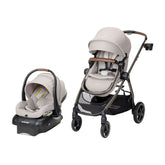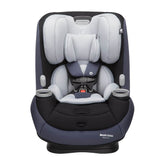Baby-Led Weaning: How to Help Your Infant Learn to Feed Themselves

Breast milk or infant formula is the primary source of nutrition for the first six months of a baby’s life. After that, the American Academy of Pediatrics (AAP) recommends continued breastfeeding or formula-feeding for the next six months, along with the introduction of solid foods. Traditionally, many parents opt to do this with thinned-out baby cereals and jars of pureed food. These days, however, more families are bypassing this method in favor of a different approach known as baby-led weaning. Let’s take a closer look at baby-led weaning, whether it's right for your family, and how to get started.
What Is Baby-Led Weaning?
Weaning is the gradual process of shifting from one type of feeding to another. It doesn’t happen overnight. Weaning takes time – the shift from formula or breast milk to exclusive solids may take months or years. Baby-led weaning is one way to do this. With baby-led weaning, babies 6 months old or older jump straight to finger foods as soon as solids are introduced, skipping purées and mashed-up foods.
What Are the Benefits of Baby-Led Weaning?
Baby-led weaning is gaining more traction in the United States for a variety of reasons. Let’s explore some of the benefits of bypassing pureed baby food and jumping directly to letting your little one feed themself.
1. It helps them learn to self-regulate.
Caregivers sometimes push a baby to eat more than they actually require. Allowing a baby to self-feed lets them consume as little or as much as they want. This can help them begin to understand when they’re full and when they’re hungry. It may also help discourage overeating and prevent excessive weight gain later in life.
2. It promotes variety.
Baby-led weaning appears to lower the odds your little one will be a picky eater since they have more control over the process. Letting them call the shots can make the process more enjoyable for them and foster healthy eating habits in the future.
3. It encourages healthy development.
Dexterity, hand-eye coordination, and fine motor skills all get a boost when a baby practices self-feeding.
4. It’s simpler and less expensive for parents.
With baby-led weaning, you simply give your baby age-appropriate versions of what the rest of the family is already eating. This saves you from having to do all the separate meal prep involved in making homemade purees and allows you to eat your own meal while keeping an eye on your baby. You also don’t have to invest in a bunch of expensive jars or store-bought purees that may look or smell weird.
How Do I Get Started With Baby-Led Weaning?
Baby-led weaning can typically start when your baby is about 6 months old. By that age, most infants can sit up by themselves, grasp bits of food, and bring it to their mouth. Babies also have a diminishing tongue-thrust reflex by this age (that’s the term for when they use their tongue to spit something out of their mouth). That said, some babies aren’t ready until a little later, particularly babies who were born prematurely.
Just as you would for traditional baby feeding methods, you’ll need a high chair and bibs, as well as baby-sized silverware and dishes for baby-led weaning.
Your baby may not eat much when you first get started. This is normal. Over time, your baby will figure out self-feeding and begin eating more. (Keep in mind, breast milk or formula will still be your little one’s primary source of nutrition until they’re at least one year old.)
What Are Good First Foods for Baby-Led Weaning?
Soft foods cut into “finger-sized” slices are perfect for little ones to grab. It should be firm enough that they can grasp it easily, long enough that they can have a visible bit sticking out from their hand, and soft enough to gum and chew. Examples may include the following:
- Strips of soft, very ripe fruit, like banana, pear, avocado, kiwi, or mango.
- Spears of roasted, baked, or steamed vegetables, like sweet potatoes, carrots, or squash.
- Ground meat or soft, shredded strips of meat that you can move your fingers through.
Baby-led weaning doesn’t mean you have to bypass purees and soft-textured foods completely. Adults eat those, too! Applesauce, oatmeal, and plain whole-fat or Greek yogurt are wonderful early foods for babies.
What Foods Should I Avoid With Baby-Led Weaning?
Certain foods that are easy for adults to chew and swallow can be dangerous for little ones. Big, hard, raw, solid, or chunky foods can get lodged in a baby’s throat and obstruct their breathing. Here are some of the most common food choking hazards for babies and young children:
- Dried fruit, like raisins
- Gum, lollipops, or hard candy
- Hot dogs
- Firm, round foods, such as whole berries and whole grapes (should be cut or smooshed)
- Hard, crunchy foods, such as chips, popcorn, nuts
- Raw, hard-textured vegetables, like carrots
- Peanut butter offered alone, which can be too sticky for babies to safely manage
Babies younger than one year of age also should never consume certain foods, including:
- Honey, due to the risk of botulism.
- Whole cow’s milk to drink, due to the risk of digestive tract bleeding and not having the right blend of nutrients. Small amounts of milk used in cooking or food preparation are typically permissible, as are other dairy products, such as yogurt and cheese.

Tips for Success With Baby-Led Weaning
Every little one is different. Some babies have no desire to even touch the food on their high chair trays, while others are trying to snatch food from your plate before they’re even ready for solids. When it comes to baby-led weaning, your baby guides the process. Take a look at these tips to help you and your baby be successful with baby-led weaning.
1. Begin with easy foods.
Small strips of soft banana, ripe avocado, or baked sweet potato are just right for beginners. In the beginning, you only need to put a couple of pieces of food in front of your baby at mealtimes. Your baby may find more than that overwhelming.
2. Embrace the mess.
Baby-led weaning is about letting your child learn about textures and tastes. It’s messy. You’ll have food on the highchair, on the floor, and in their hair. This is part of letting them explore their independence and get comfortable with food. Invest in a great bib or smock, put a mat under their chair, and consider dressing them in only a diaper to make clean-up a little easier.
3. Choose healthy foods.
Prioritize offering whole foods, like vegetables, fruit, or meats, over processed food and snacks. Cereal puffs and crackers aren’t bad, but your little one may be less likely to choose healthier foods when you offer them later.
4. Always keep an eye on your baby.
Your baby may need some help getting food to their mouth at first. They might even gag a little. As your infant gets older and more curious about food, they’ll still need you to be nearby keeping watch. Stay near your child in case you need to jump in and help.
The Takeaway
Baby-led weaning, like so many other techniques in parenting, doesn’t have to be all-or-nothing. It’s alright to spoon-feed your baby for some meals and let them self-feed for others. Some little ones prefer to be spoon-fed. Others like to try feeding themselves. As long as your little one is healthy and getting the nutrients they need to thrive, you can choose the technique or combination of techniques that works best for your family.









